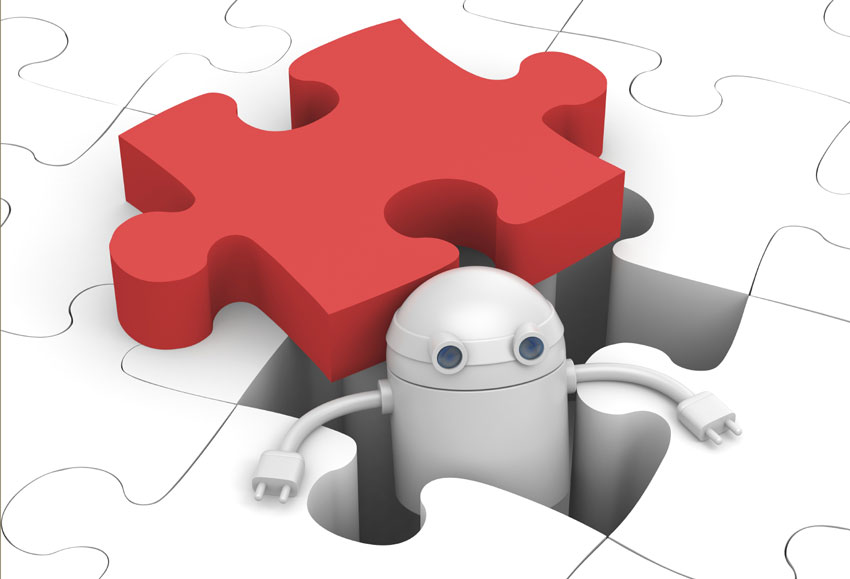
Robohub.org
Automation, not domination: How robots will take over our world

The first question people tend to ask when they find out you are a roboticist is, “When are robots going to take over the world and become our masters?” The answer to this question is a big “Never!”
Robots and artificial intelligence (AI) will, however, “take over” the world by invading and hopefully enhancing every aspect of people’s lives. More likely than sentient Skynet-style robot overlords are collections of robot applications that will help us increase productivity and improve our quality of life through human-robot collaboration.(a)
This article is written to inform readers about the questions they should be asking about robots, the ones that more accurately reflect the future of robotics and artificial intelligence technology and their possible impacts on society. Think of this as an “FAQ” on robots.
What is a robot?
“Robot” is a catchy term that most people can intuitively grasp. The problem is that it is purely a creation of science fiction.(b) There is no specific definition or basis in science for the term, and as a result, it can generate much confusion about what is and is not a robot. Such discussions tend to lead to philosophical arguments about the nature of free will and choice, determinism and fate, or the meaning of life. These conversations are fun, but not very useful.
A more useful and accurate term is automation. What we think of as a robot is more accurately defined as a “machine that automates physical effort.” Similarly, automation accurately defines computing as “the automation of information processing” and telecommunications as “the automation of messaging information.”1 Ceiling fans, programmable thermostats, cruise control, and construction shovel excavators are all examples of automated physical tasks prevalent in daily life. Even physical tasks with life-and-death consequences, such as autopilot on commercial air flights, have been successfully automated.
Automation involves different levels of autonomy. At one extreme are purely remote-controlled devices (shovel excavators, remote-controlled helicopters), relying solely on human operators to direct their actions. This is typically described as teleoperation. On the other end of the spectrum are purely autonomous machines that operate independent of direct control from humans. Efforts to build more autonomous machines have led to a focus on creating machines with artificial intelligence that can “think” using mathematical rules and reasoning.
What can robots do?
Science fiction often envisions autonomous robots with the full capabilities of humans, such as navigation of complex environments, dexterous manipulation of physical objects, and learning from experience and instruction.(c) The reality, however, is that human perception and decision-making remain eons beyond what can be automated through computation and engineering. Robots cannot handle the uncertainty caused by the perceptual ambiguity involved in sensing the world, the random aspects of physical cause and effect, and the complex nature of social dynamics. The creativity and ingenuity of people to perceive and act in uncertain situations gives them a huge advantage over the scripted, rule-based nature of automated logic and control.
Thus far, automated machines have only matched human capabilities in either highly controlled environments amenable to open-loop control, where motions are executed without regard to sensory feedback (for example, an industrial robot arm in a factory), or in highly prescribed tasks with limited generalizability, where smart design and engineering produce the desired behavior (for example, a robot vacuum cleaner).
This raises the question people should actually be asking about robots: “What tasks and activities should we automate?” In other words, “When is automation better than human effort, when is human effort better than automation, and, most importantly, how can we combine the best of both human effort and automation?” Such inquiries have led to the concept of shared (or adjustable) autonomy – humans and automation working together to achieve better results than either could alone.2 The control of various aircrafts, from commercial planes to military drones, is a common example of adjustable autonomy. Automated controls can execute scriptable tasks, such as following a flight path of GPS waypoints, but a flight crew is always needed to handle any exceptional situations that arise.

When will robots take my job?
Depending on the nature of your job, this could be a very real concern. Automation in the form of computers and robots will not completely overtake the human workforce. Instead, these technologies will lead to a shift in the nature of labor, as computers have in recent decades.
As scholars Frank Levy and Richard J. Murnane suggest, the right question to be asking about any job is, “What is the best balance between the creativity and cognitive power provided by humans and the speed and reliability of automated machines?”3 People are much more adept than machines at tasks that involve creativity and adaptation in problem solving, which is common in our day-to-day life and work. In contrast, robots are often better at carrying out work that conforms to specific sets of rules and knowledge that can be described mathematically and scripted computationally as a program. Therefore, the overall effect of increasing computerization and automation will lead not to mass unemployment, but rather to a decline in less-skilled jobs that involve repetitive, task-oriented labor.3
Technologist Martin Ford estimates that over 50 million jobs in the United States are immediately susceptible to replacement by automated software, a figure that represents more than 40% of the U.S. workforce.4 Manual labor and routine cognitive tasks are already being done by manufacturing robots in factories and self-checkout machines in grocery stores.3 Robots may not only perform existing jobs more efficiently, but also fill needs in fields like elder care where labor is scarce or volatile, or do work that is inefficient, dangerous, or impractical for humans, such as infrastructure inspection and repair.
This shift in labor will change the types of jobs available to people. In order to function in the higher-level jobs that robot labor will require people to occupy, younger generations will need to adapt to the increasing presence of technology in the workplace. Business experts Andrew McAfee and Erik Brynjolfsson argue that this human displacement will require education reform to better prepare people for the future job market.5
While robots will significantly alter the job market, they will also increase productivity, potentially raising profits for owners of capital and increasing quality of life for consumers by lowering costs and improving services. Some roboticists, such as Rethink Robotics founder Rodney Brooks, claim that shared human-robot automation of the workforce will ultimately benefit the economy and society. President Obama echoed this claim in a speech at Carnegie Mellon University introducing the National Robotics Initiative, in which he touted robotics as a promising mechanism for reviving American manufacturing.(d)
What should we fear from robots?
A more legitimate fear than a complete robot take-over is abuse by the humans in control of robots. On their own, robots will not likely have the cognitive capability to carry out sophisticated malicious actions. People, however, can manipulate robots to engage in destructive behaviors that go beyond what any individual human can do.
One of the more worrisome possibilities is the misuse of new weapons technology. The growing use of unmanned aerial drones, ground vehicles, and underwater systems by the military and law enforcement raises concerns about weaponization and abuse of these technologies. The core principles (or at least expert speculation) underlying almost any technology, including weapons, can be found in online message boards, wikis, tutorials, and open-source software repositories. While there are several steps from principles and blueprints to implementation, this free flow of information lowers barriers preventing organizations and individuals from creating automated weapons.(e)
While the potential for misuse of robotic weapons systems may be the most alarming possibility, far more mundane automated systems are also vulnerable to hacking, such as “home automation” systems for smart and adaptive lights, refrigerators, garage door openers, and even toilets. To illustrate this point, computer scientists Charlie Miller and Chris Valasek hacked into a Ford Escape, causing it to crash even when the driver slammed on the brakes. Another group of researchers hacked into wireless tire pressure monitors, which can be used to track a vehicle or cause it to malfunction. These experiments make it clear that the risk of hacking and abuse should be addressed during the development of new automated systems. Yet, while we should guard against efforts to manipulate technology to our disadvantage, the overall promise of automation is that it has enormous potential to improve our quality of life.
Conclusion
Robotics is poised to generate disruptive technologies across all sectors of society, changing life in our workplaces, homes, skies, factories, and schools, just to name a few. Much of the controversy surrounding these technologies is based on misguided fears. One of the ways in which concerns may be assuaged is through proactive learning about the true capabilities, limitations, and potential uses (and misuses) of robotic and automated technology.(f) The technology of robotics is too useful for fear to suppress its progress. By marrying the true needs of society with an accurate understanding of advanced technology, we can develop innovations that will lead to the equitable advancement of our world.
Odest Chadwicke Jenkins, Ph.D., is an Associate Professor of Computer Science at Brown University. Prof. Jenkins was selected as a Sloan Research Fellow in 2009 and is a recipient of the Presidential Early Career Award for Scientists and Engineers (PECASE) and Young Investigator awards from the Office of Naval Research (ONR), the Air Force Office of Scientific Research (AFOSR), and the National Science Foundation (NSF). National Geographic recently featured him as an emerging explorer. His research addresses problems in robot learning and human-robot interaction.
Alexandra is a current fourth-year student at Brown University pursuing an B.S. in Environmental Science. She recently worked as a Senior Research Assistant in Computer Science for Brown’s Humanity-Centered Robotics Initiative (HCRI), studying applications of robotics in health care, agriculture, manufacturing, defense, education, and space. Brown selected the HCRI among competing proposals as a Signature Academic Initiative.
This article was originally published on Footnote, a website that shares academic research in a format that mainstream readers can understand and engage with. It is part of Footnote’s multidisciplinary series on robots and their impact on society. Please contact Footnote for permission before republishing this article.
ENDNOTES
- Thomas B. Sheridan (1992) Telerobotics, Automation, and Human Supervisory Control, Cambridge, MA: MIT Press.
- Michael A. Goodrich, Dan R. Olsen Jr., Jacob W. Crandall, and Thomas J. Palmer (2001) “Experiments in Adjustable Autonomy,” Proceedings of the IEE International Conference on Systems, Man, and Cybernetics, 3: 1624-1629.
- Frank Levy and Richard J. Murnane (2004) The New Division of Labor: How Computers Are Creating the Next Job Market, Princeton, NJ: Russell Sage Foundation and Princeton University Press.
- Martin Ford (2009) The Lights in the Tunnel: Automation, Accelerating Technology and the Economy of the Future,CreateSpace Independent Publishing Platform.
- Erik Brynjolfsson and Andrew McAfee (2011) Race Against the Machine: How the digital revolution is accelerating innovation, driving productivity, and irreversibly transforming employment and the economy, Digital Frontier Press.
If you liked this article, you may also be interested in:
- The great equalizer: How robotics frees manufacturers from consolidating in low-wage nations
- Ability to do creative, non-routine work will be a must in the coming automation era. Is this realistic for most workers?
- Do robots kill jobs?
- Jobs isn’t the issue for robotics
- In agriculture robots replace job vacancies
See all the latest robotics news on Robohub, or sign up for our weekly newsletter.
tags: Automation, c-Politics-Law-Society, cx-Business-Finance, robots and jobs








